Economics Homework: Analyzing Production, Costs, and Market Behavior
VerifiedAdded on 2022/08/19
|23
|1910
|20
Homework Assignment
AI Summary
This document presents solutions to an economics homework assignment covering multiple chapters. The solutions include detailed calculations and explanations for problems related to production costs, market structures, and pricing strategies. Specifically, the assignment analyzes topics such as fixed and variable costs, profit maximization, and marginal returns in Chapter 5. Chapter 7 addresses concentration ratios and Lerner indices. Chapter 8 examines short-run and long-run output decisions, and Chapter 9 and 10 delves into oligopoly models like Cournot, Stackelberg, and Bertrand. Chapter 11 explores price discrimination strategies, and Chapter 12 focuses on expected value, variance, and profit maximization under uncertainty. The solutions provide insights into various economic concepts and their application in different market scenarios. The assignment is designed to help students understand core economic principles and apply them to real-world situations.
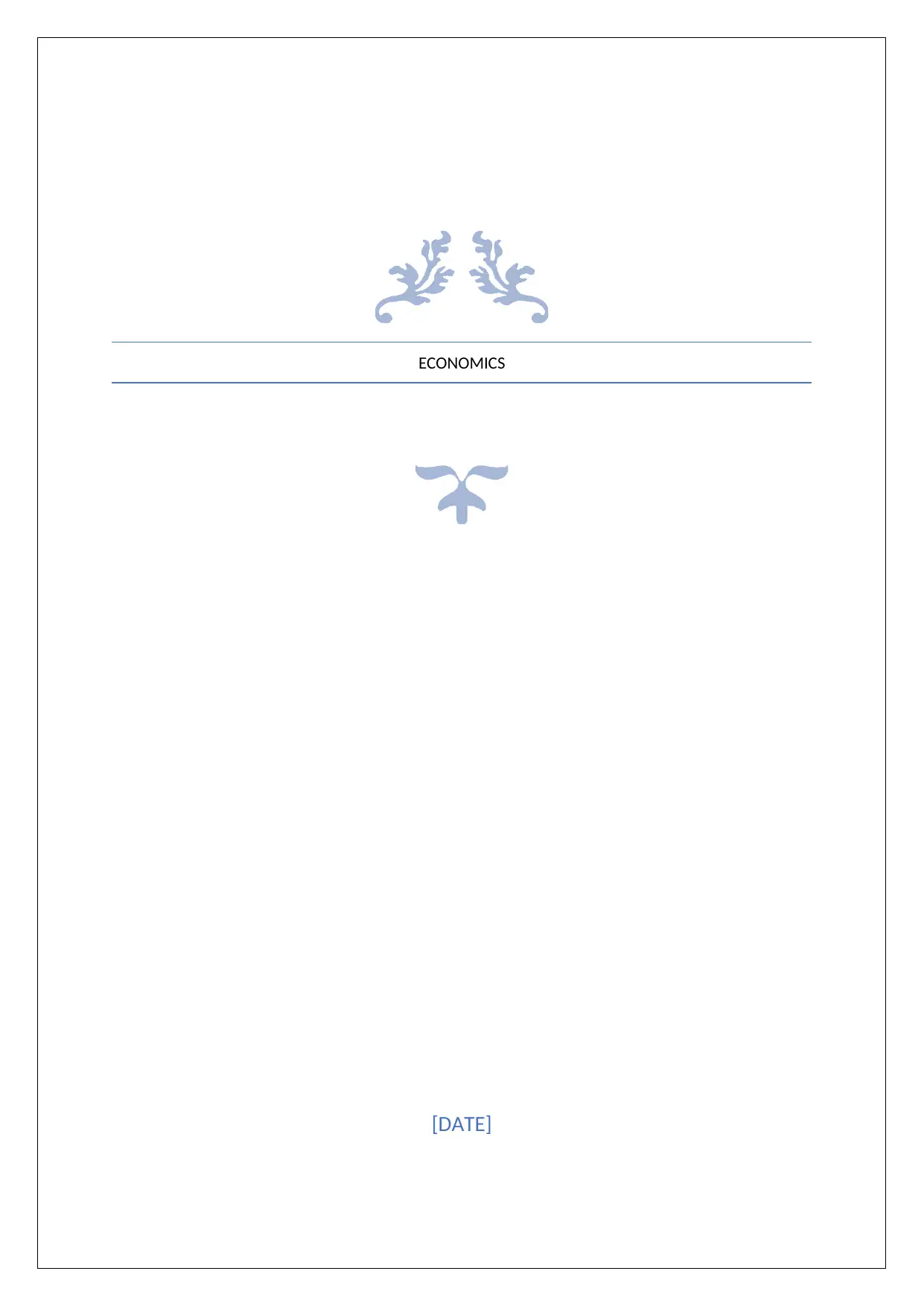
ECONOMICS
[DATE]
[DATE]
Paraphrase This Document
Need a fresh take? Get an instant paraphrase of this document with our AI Paraphraser
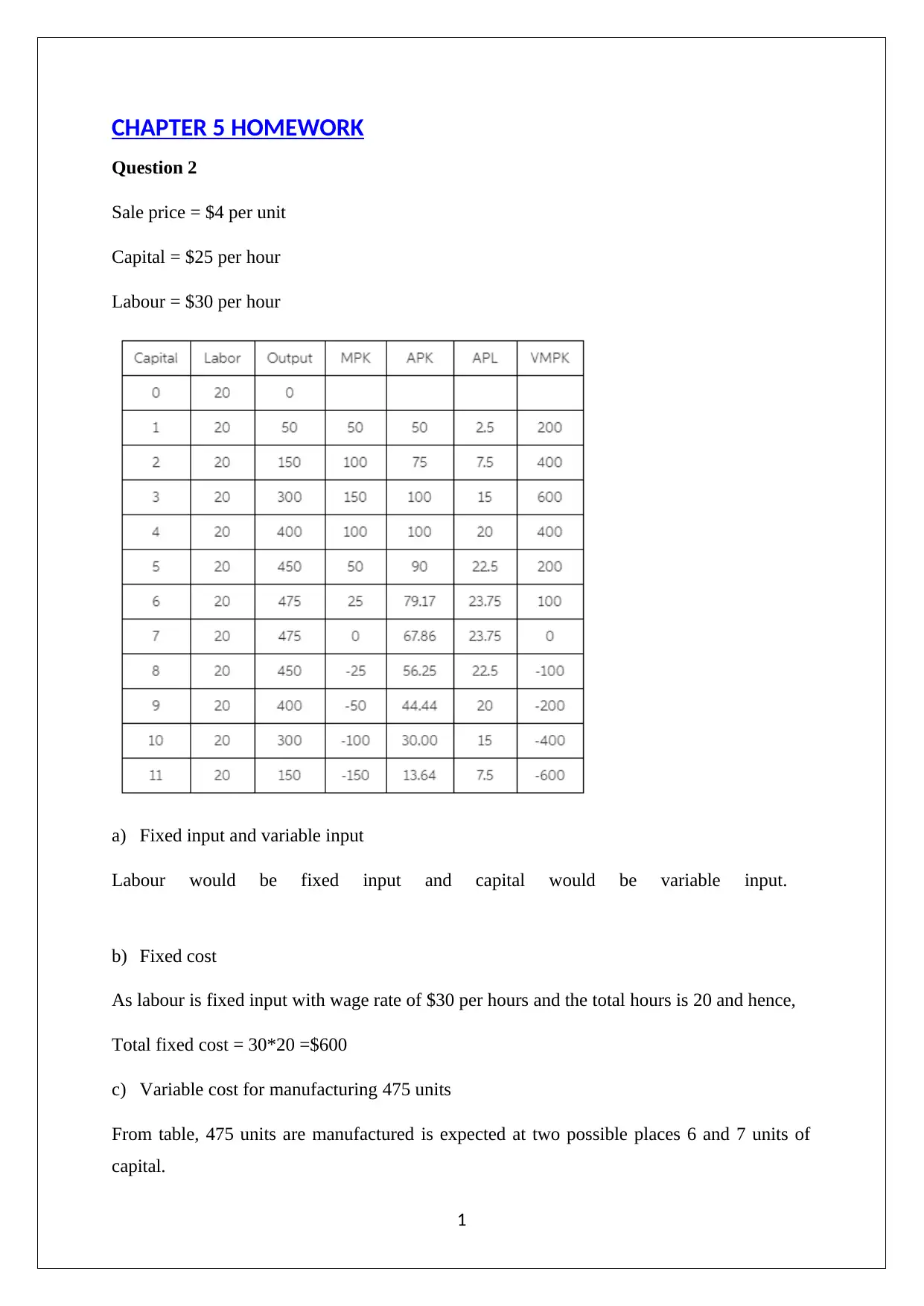
CHAPTER 5 HOMEWORK
Question 2
Sale price = $4 per unit
Capital = $25 per hour
Labour = $30 per hour
a) Fixed input and variable input
Labour would be fixed input and capital would be variable input.
b) Fixed cost
As labour is fixed input with wage rate of $30 per hours and the total hours is 20 and hence,
Total fixed cost = 30*20 =$600
c) Variable cost for manufacturing 475 units
From table, 475 units are manufactured is expected at two possible places 6 and 7 units of
capital.
1
Question 2
Sale price = $4 per unit
Capital = $25 per hour
Labour = $30 per hour
a) Fixed input and variable input
Labour would be fixed input and capital would be variable input.
b) Fixed cost
As labour is fixed input with wage rate of $30 per hours and the total hours is 20 and hence,
Total fixed cost = 30*20 =$600
c) Variable cost for manufacturing 475 units
From table, 475 units are manufactured is expected at two possible places 6 and 7 units of
capital.
1
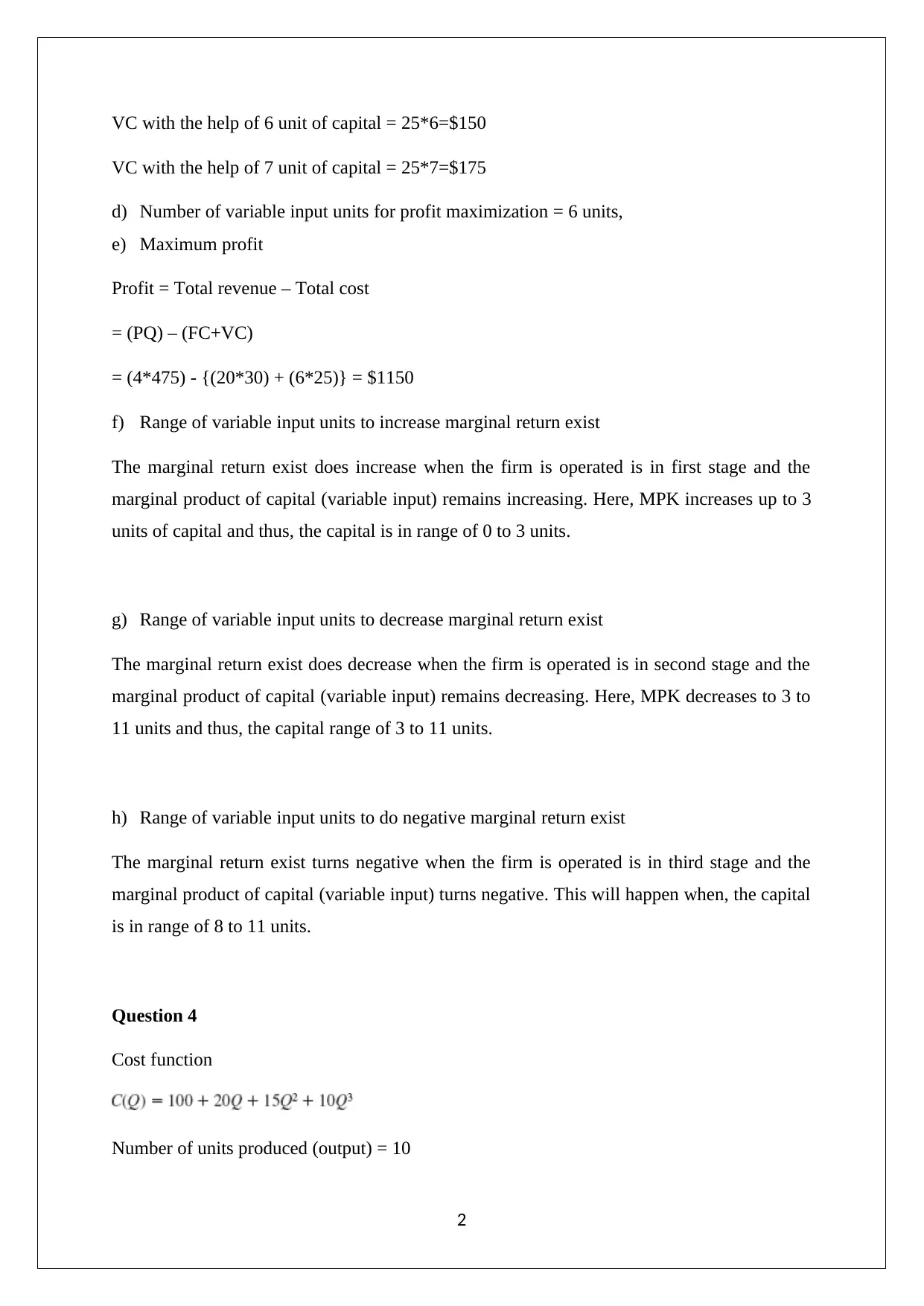
VC with the help of 6 unit of capital = 25*6=$150
VC with the help of 7 unit of capital = 25*7=$175
d) Number of variable input units for profit maximization = 6 units,
e) Maximum profit
Profit = Total revenue – Total cost
= (PQ) – (FC+VC)
= (4*475) - {(20*30) + (6*25)} = $1150
f) Range of variable input units to increase marginal return exist
The marginal return exist does increase when the firm is operated is in first stage and the
marginal product of capital (variable input) remains increasing. Here, MPK increases up to 3
units of capital and thus, the capital is in range of 0 to 3 units.
g) Range of variable input units to decrease marginal return exist
The marginal return exist does decrease when the firm is operated is in second stage and the
marginal product of capital (variable input) remains decreasing. Here, MPK decreases to 3 to
11 units and thus, the capital range of 3 to 11 units.
h) Range of variable input units to do negative marginal return exist
The marginal return exist turns negative when the firm is operated is in third stage and the
marginal product of capital (variable input) turns negative. This will happen when, the capital
is in range of 8 to 11 units.
Question 4
Cost function
Number of units produced (output) = 10
2
VC with the help of 7 unit of capital = 25*7=$175
d) Number of variable input units for profit maximization = 6 units,
e) Maximum profit
Profit = Total revenue – Total cost
= (PQ) – (FC+VC)
= (4*475) - {(20*30) + (6*25)} = $1150
f) Range of variable input units to increase marginal return exist
The marginal return exist does increase when the firm is operated is in first stage and the
marginal product of capital (variable input) remains increasing. Here, MPK increases up to 3
units of capital and thus, the capital is in range of 0 to 3 units.
g) Range of variable input units to decrease marginal return exist
The marginal return exist does decrease when the firm is operated is in second stage and the
marginal product of capital (variable input) remains decreasing. Here, MPK decreases to 3 to
11 units and thus, the capital range of 3 to 11 units.
h) Range of variable input units to do negative marginal return exist
The marginal return exist turns negative when the firm is operated is in third stage and the
marginal product of capital (variable input) turns negative. This will happen when, the capital
is in range of 8 to 11 units.
Question 4
Cost function
Number of units produced (output) = 10
2
⊘ This is a preview!⊘
Do you want full access?
Subscribe today to unlock all pages.

Trusted by 1+ million students worldwide
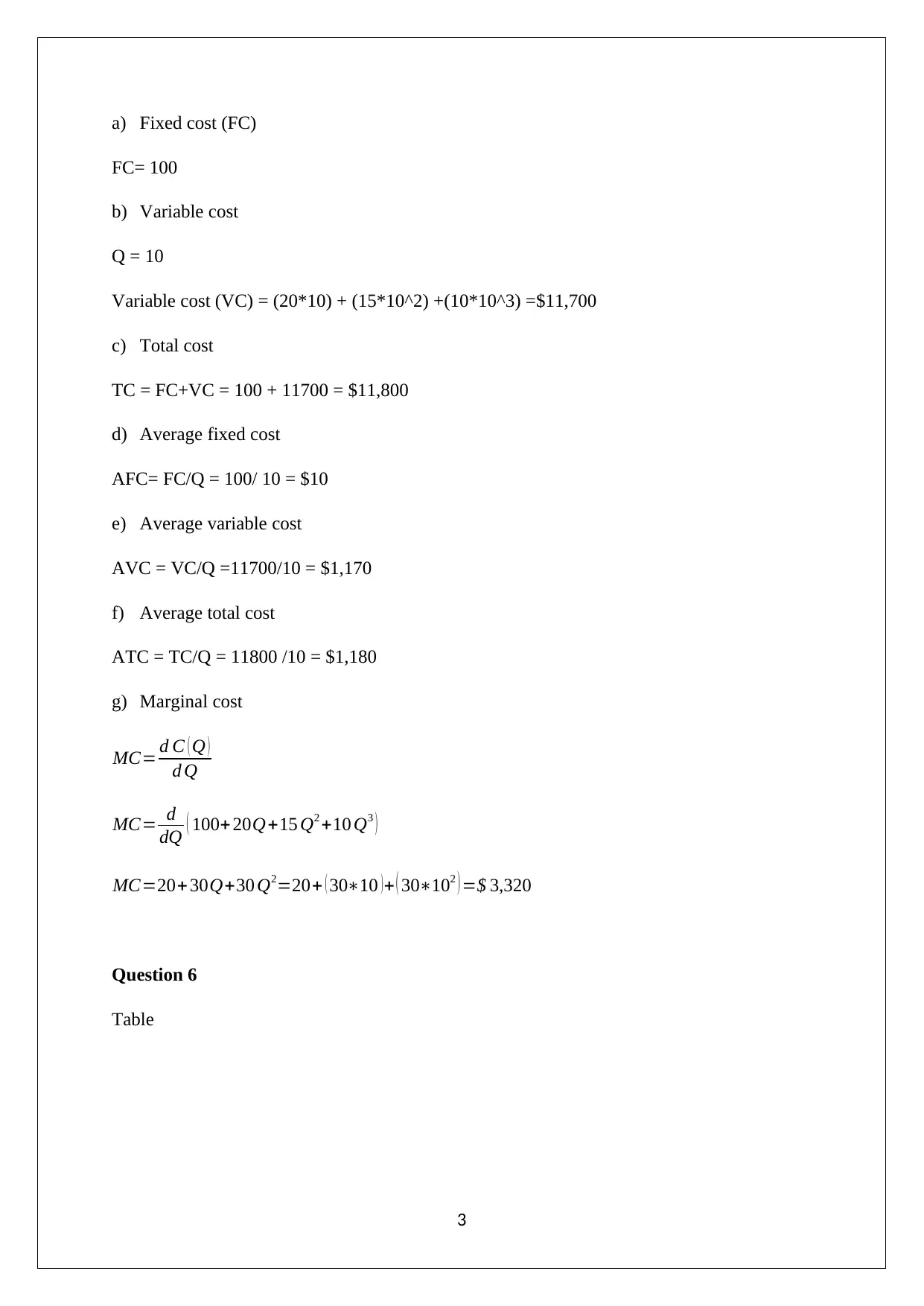
a) Fixed cost (FC)
FC= 100
b) Variable cost
Q = 10
Variable cost (VC) = (20*10) + (15*10^2) +(10*10^3) =$11,700
c) Total cost
TC = FC+VC = 100 + 11700 = $11,800
d) Average fixed cost
AFC= FC/Q = 100/ 10 = $10
e) Average variable cost
AVC = VC/Q =11700/10 = $1,170
f) Average total cost
ATC = TC/Q = 11800 /10 = $1,180
g) Marginal cost
MC= d C ( Q )
d Q
MC= d
dQ ( 100+ 20Q+15 Q2 +10 Q3 )
MC=20+ 30Q+30 Q2=20+ ( 30∗10 )+ ( 30∗102 ) =$ 3,320
Question 6
Table
3
FC= 100
b) Variable cost
Q = 10
Variable cost (VC) = (20*10) + (15*10^2) +(10*10^3) =$11,700
c) Total cost
TC = FC+VC = 100 + 11700 = $11,800
d) Average fixed cost
AFC= FC/Q = 100/ 10 = $10
e) Average variable cost
AVC = VC/Q =11700/10 = $1,170
f) Average total cost
ATC = TC/Q = 11800 /10 = $1,180
g) Marginal cost
MC= d C ( Q )
d Q
MC= d
dQ ( 100+ 20Q+15 Q2 +10 Q3 )
MC=20+ 30Q+30 Q2=20+ ( 30∗10 )+ ( 30∗102 ) =$ 3,320
Question 6
Table
3
Paraphrase This Document
Need a fresh take? Get an instant paraphrase of this document with our AI Paraphraser
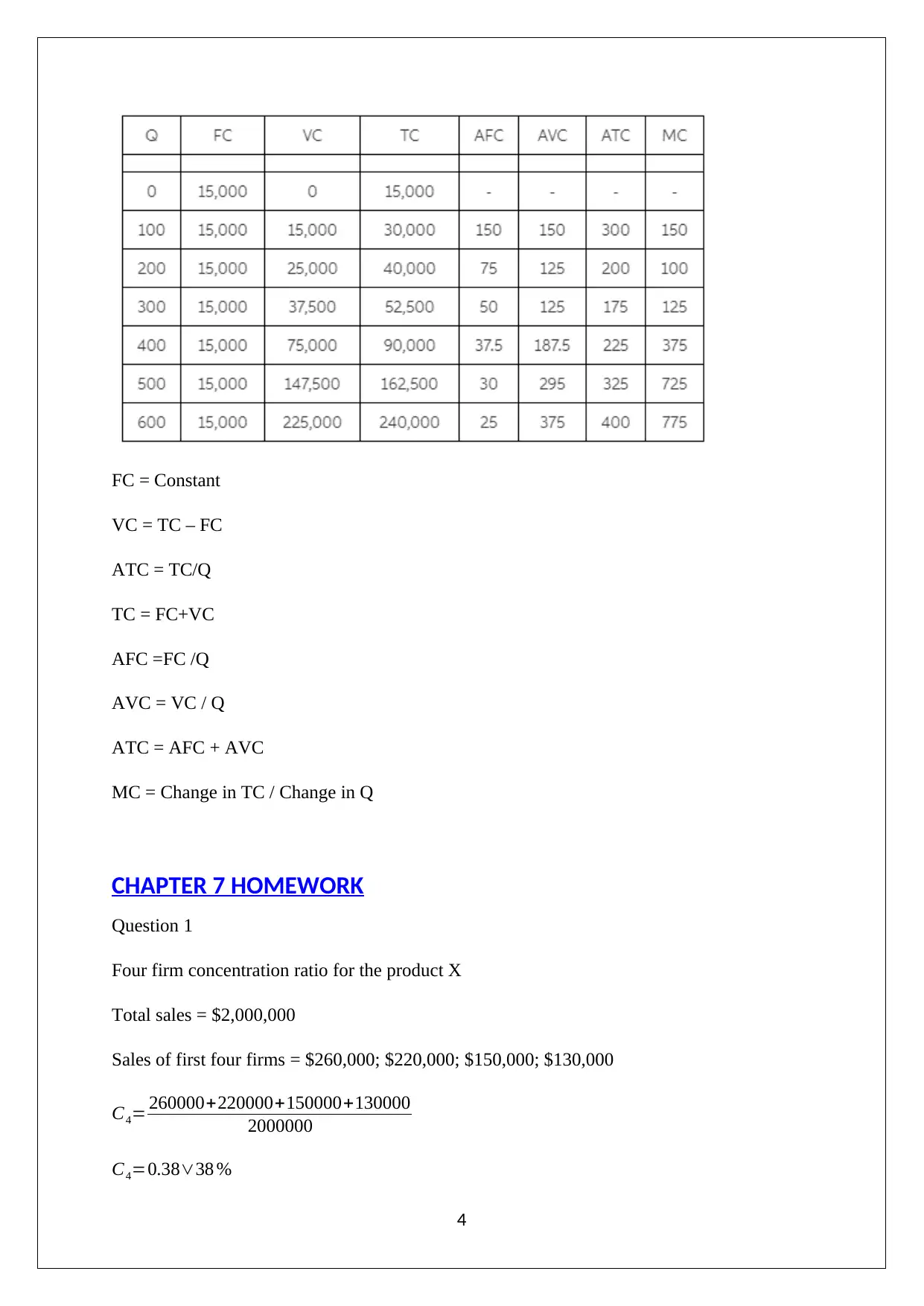
FC = Constant
VC = TC – FC
ATC = TC/Q
TC = FC+VC
AFC =FC /Q
AVC = VC / Q
ATC = AFC + AVC
MC = Change in TC / Change in Q
CHAPTER 7 HOMEWORK
Question 1
Four firm concentration ratio for the product X
Total sales = $2,000,000
Sales of first four firms = $260,000; $220,000; $150,000; $130,000
C4= 260000+220000+150000+130000
2000000
C4=0.38∨38 %
4
VC = TC – FC
ATC = TC/Q
TC = FC+VC
AFC =FC /Q
AVC = VC / Q
ATC = AFC + AVC
MC = Change in TC / Change in Q
CHAPTER 7 HOMEWORK
Question 1
Four firm concentration ratio for the product X
Total sales = $2,000,000
Sales of first four firms = $260,000; $220,000; $150,000; $130,000
C4= 260000+220000+150000+130000
2000000
C4=0.38∨38 %
4
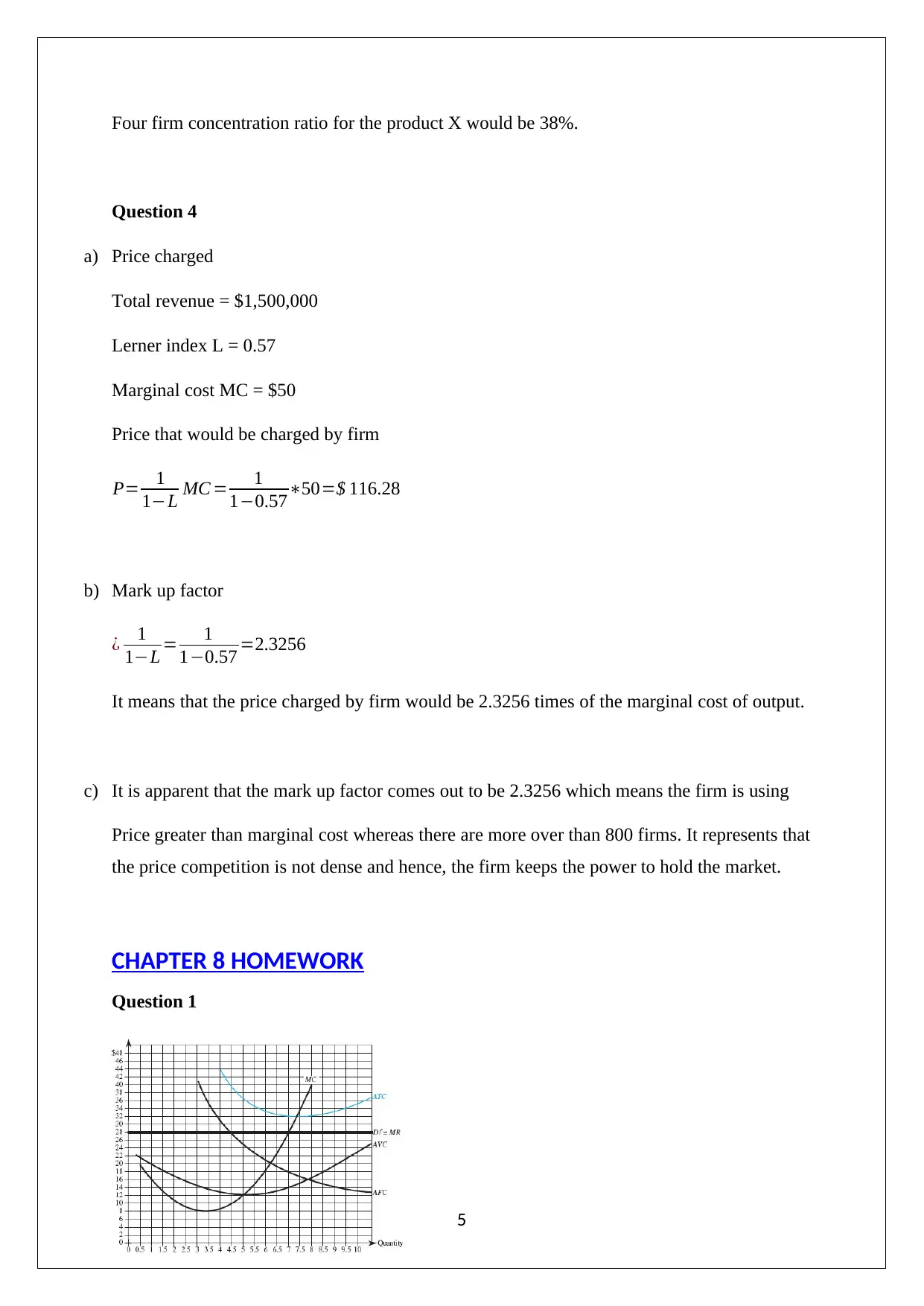
Four firm concentration ratio for the product X would be 38%.
Question 4
a) Price charged
Total revenue = $1,500,000
Lerner index L = 0.57
Marginal cost MC = $50
Price that would be charged by firm
P= 1
1−L MC = 1
1−0.57∗50=$ 116.28
b) Mark up factor
¿ 1
1−L = 1
1−0.57 =2.3256
It means that the price charged by firm would be 2.3256 times of the marginal cost of output.
c) It is apparent that the mark up factor comes out to be 2.3256 which means the firm is using
Price greater than marginal cost whereas there are more over than 800 firms. It represents that
the price competition is not dense and hence, the firm keeps the power to hold the market.
CHAPTER 8 HOMEWORK
Question 1
5
Question 4
a) Price charged
Total revenue = $1,500,000
Lerner index L = 0.57
Marginal cost MC = $50
Price that would be charged by firm
P= 1
1−L MC = 1
1−0.57∗50=$ 116.28
b) Mark up factor
¿ 1
1−L = 1
1−0.57 =2.3256
It means that the price charged by firm would be 2.3256 times of the marginal cost of output.
c) It is apparent that the mark up factor comes out to be 2.3256 which means the firm is using
Price greater than marginal cost whereas there are more over than 800 firms. It represents that
the price competition is not dense and hence, the firm keeps the power to hold the market.
CHAPTER 8 HOMEWORK
Question 1
5
⊘ This is a preview!⊘
Do you want full access?
Subscribe today to unlock all pages.

Trusted by 1+ million students worldwide
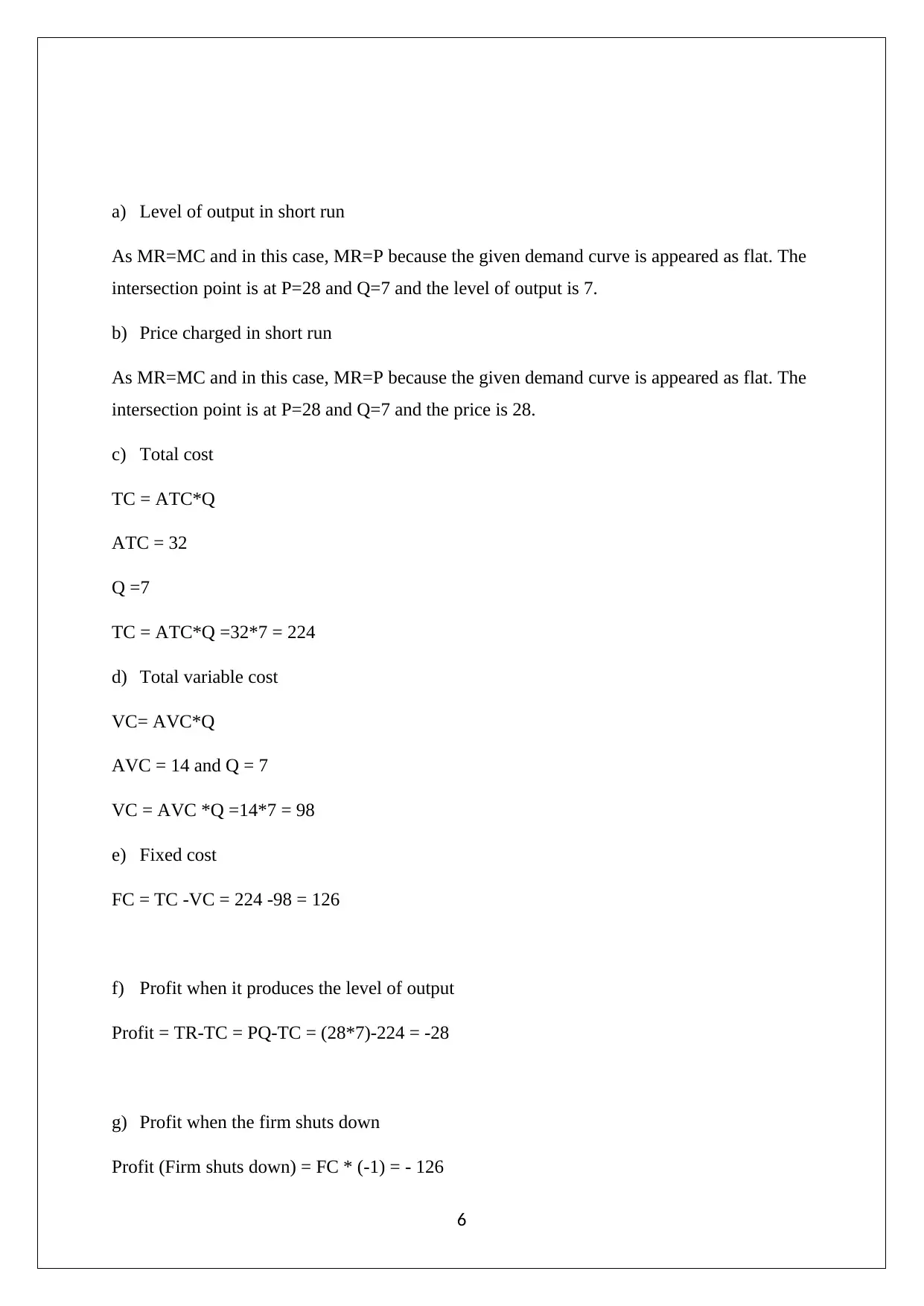
a) Level of output in short run
As MR=MC and in this case, MR=P because the given demand curve is appeared as flat. The
intersection point is at P=28 and Q=7 and the level of output is 7.
b) Price charged in short run
As MR=MC and in this case, MR=P because the given demand curve is appeared as flat. The
intersection point is at P=28 and Q=7 and the price is 28.
c) Total cost
TC = ATC*Q
ATC = 32
Q =7
TC = ATC*Q =32*7 = 224
d) Total variable cost
VC= AVC*Q
AVC = 14 and Q = 7
VC = AVC *Q =14*7 = 98
e) Fixed cost
FC = TC -VC = 224 -98 = 126
f) Profit when it produces the level of output
Profit = TR-TC = PQ-TC = (28*7)-224 = -28
g) Profit when the firm shuts down
Profit (Firm shuts down) = FC * (-1) = - 126
6
As MR=MC and in this case, MR=P because the given demand curve is appeared as flat. The
intersection point is at P=28 and Q=7 and the level of output is 7.
b) Price charged in short run
As MR=MC and in this case, MR=P because the given demand curve is appeared as flat. The
intersection point is at P=28 and Q=7 and the price is 28.
c) Total cost
TC = ATC*Q
ATC = 32
Q =7
TC = ATC*Q =32*7 = 224
d) Total variable cost
VC= AVC*Q
AVC = 14 and Q = 7
VC = AVC *Q =14*7 = 98
e) Fixed cost
FC = TC -VC = 224 -98 = 126
f) Profit when it produces the level of output
Profit = TR-TC = PQ-TC = (28*7)-224 = -28
g) Profit when the firm shuts down
Profit (Firm shuts down) = FC * (-1) = - 126
6
Paraphrase This Document
Need a fresh take? Get an instant paraphrase of this document with our AI Paraphraser
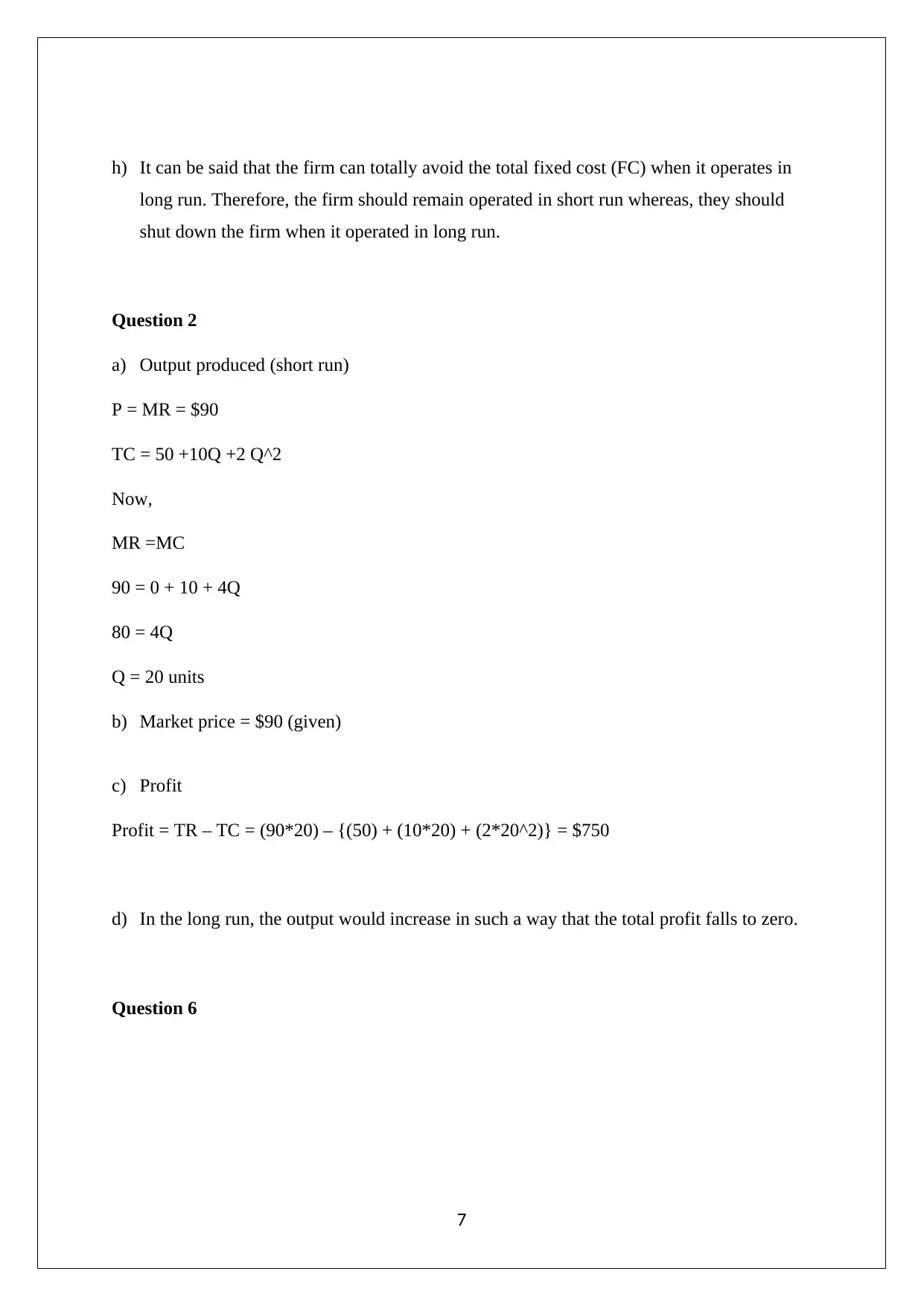
h) It can be said that the firm can totally avoid the total fixed cost (FC) when it operates in
long run. Therefore, the firm should remain operated in short run whereas, they should
shut down the firm when it operated in long run.
Question 2
a) Output produced (short run)
P = MR = $90
TC = 50 +10Q +2 Q^2
Now,
MR =MC
90 = 0 + 10 + 4Q
80 = 4Q
Q = 20 units
b) Market price = $90 (given)
c) Profit
Profit = TR – TC = (90*20) – {(50) + (10*20) + (2*20^2)} = $750
d) In the long run, the output would increase in such a way that the total profit falls to zero.
Question 6
7
long run. Therefore, the firm should remain operated in short run whereas, they should
shut down the firm when it operated in long run.
Question 2
a) Output produced (short run)
P = MR = $90
TC = 50 +10Q +2 Q^2
Now,
MR =MC
90 = 0 + 10 + 4Q
80 = 4Q
Q = 20 units
b) Market price = $90 (given)
c) Profit
Profit = TR – TC = (90*20) – {(50) + (10*20) + (2*20^2)} = $750
d) In the long run, the output would increase in such a way that the total profit falls to zero.
Question 6
7
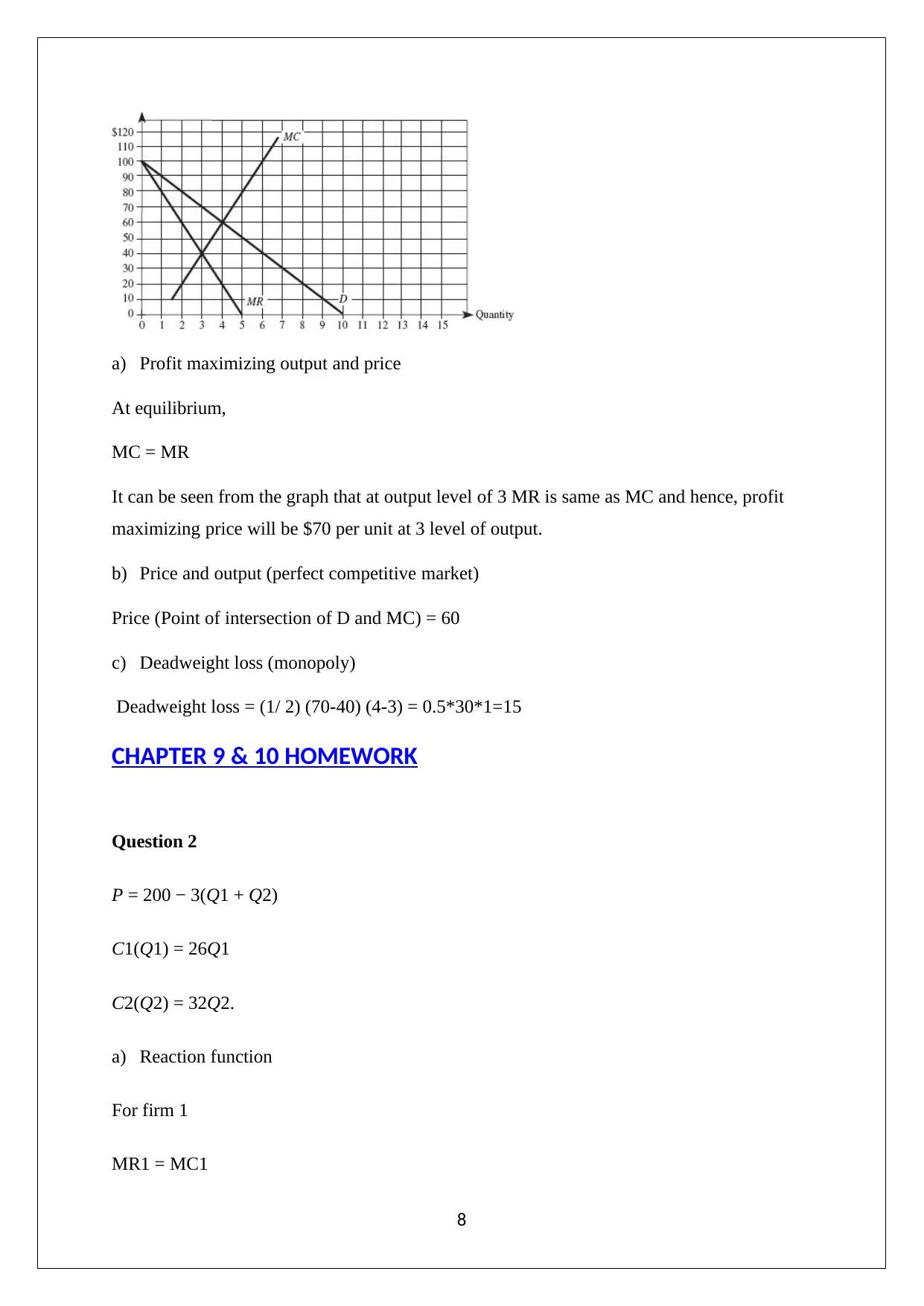
a) Profit maximizing output and price
At equilibrium,
MC = MR
It can be seen from the graph that at output level of 3 MR is same as MC and hence, profit
maximizing price will be $70 per unit at 3 level of output.
b) Price and output (perfect competitive market)
Price (Point of intersection of D and MC) = 60
c) Deadweight loss (monopoly)
Deadweight loss = (1/ 2) (70-40) (4-3) = 0.5*30*1=15
CHAPTER 9 & 10 HOMEWORK
Question 2
P = 200 − 3(Q1 + Q2)
C1(Q1) = 26Q1
C2(Q2) = 32Q2.
a) Reaction function
For firm 1
MR1 = MC1
8
At equilibrium,
MC = MR
It can be seen from the graph that at output level of 3 MR is same as MC and hence, profit
maximizing price will be $70 per unit at 3 level of output.
b) Price and output (perfect competitive market)
Price (Point of intersection of D and MC) = 60
c) Deadweight loss (monopoly)
Deadweight loss = (1/ 2) (70-40) (4-3) = 0.5*30*1=15
CHAPTER 9 & 10 HOMEWORK
Question 2
P = 200 − 3(Q1 + Q2)
C1(Q1) = 26Q1
C2(Q2) = 32Q2.
a) Reaction function
For firm 1
MR1 = MC1
8
⊘ This is a preview!⊘
Do you want full access?
Subscribe today to unlock all pages.

Trusted by 1+ million students worldwide
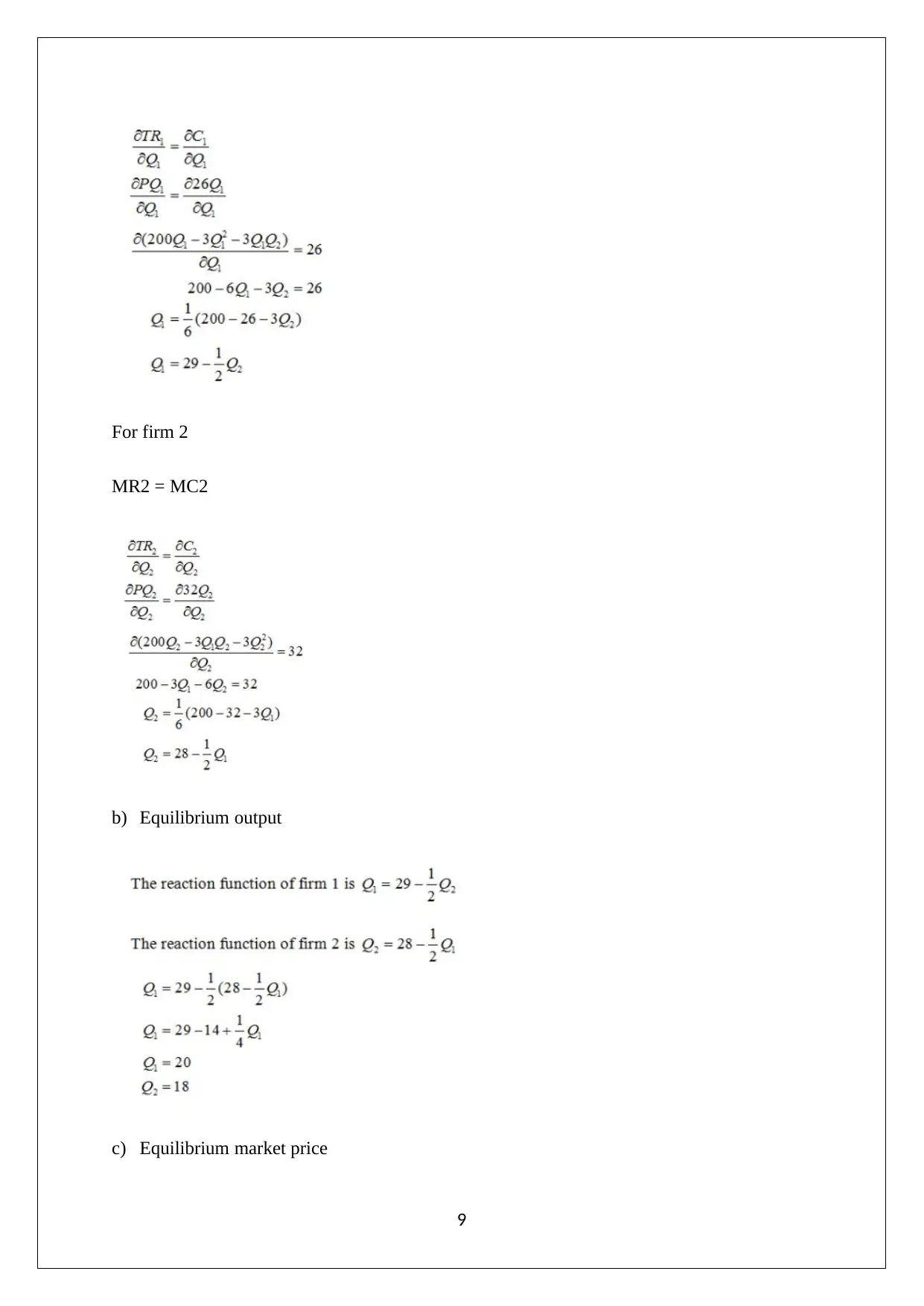
For firm 2
MR2 = MC2
b) Equilibrium output
c) Equilibrium market price
9
MR2 = MC2
b) Equilibrium output
c) Equilibrium market price
9
Paraphrase This Document
Need a fresh take? Get an instant paraphrase of this document with our AI Paraphraser
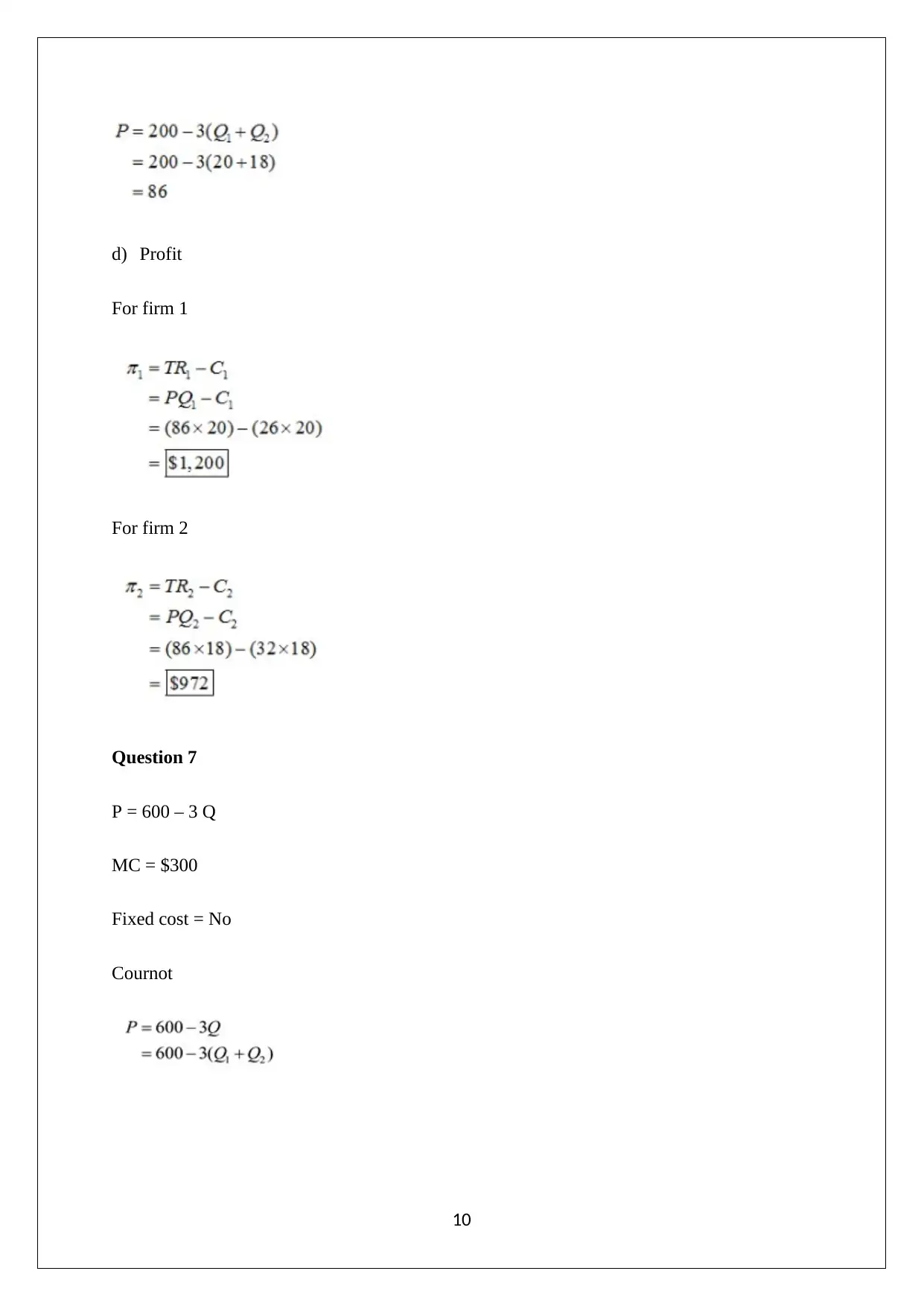
d) Profit
For firm 1
For firm 2
Question 7
P = 600 – 3 Q
MC = $300
Fixed cost = No
Cournot
10
For firm 1
For firm 2
Question 7
P = 600 – 3 Q
MC = $300
Fixed cost = No
Cournot
10
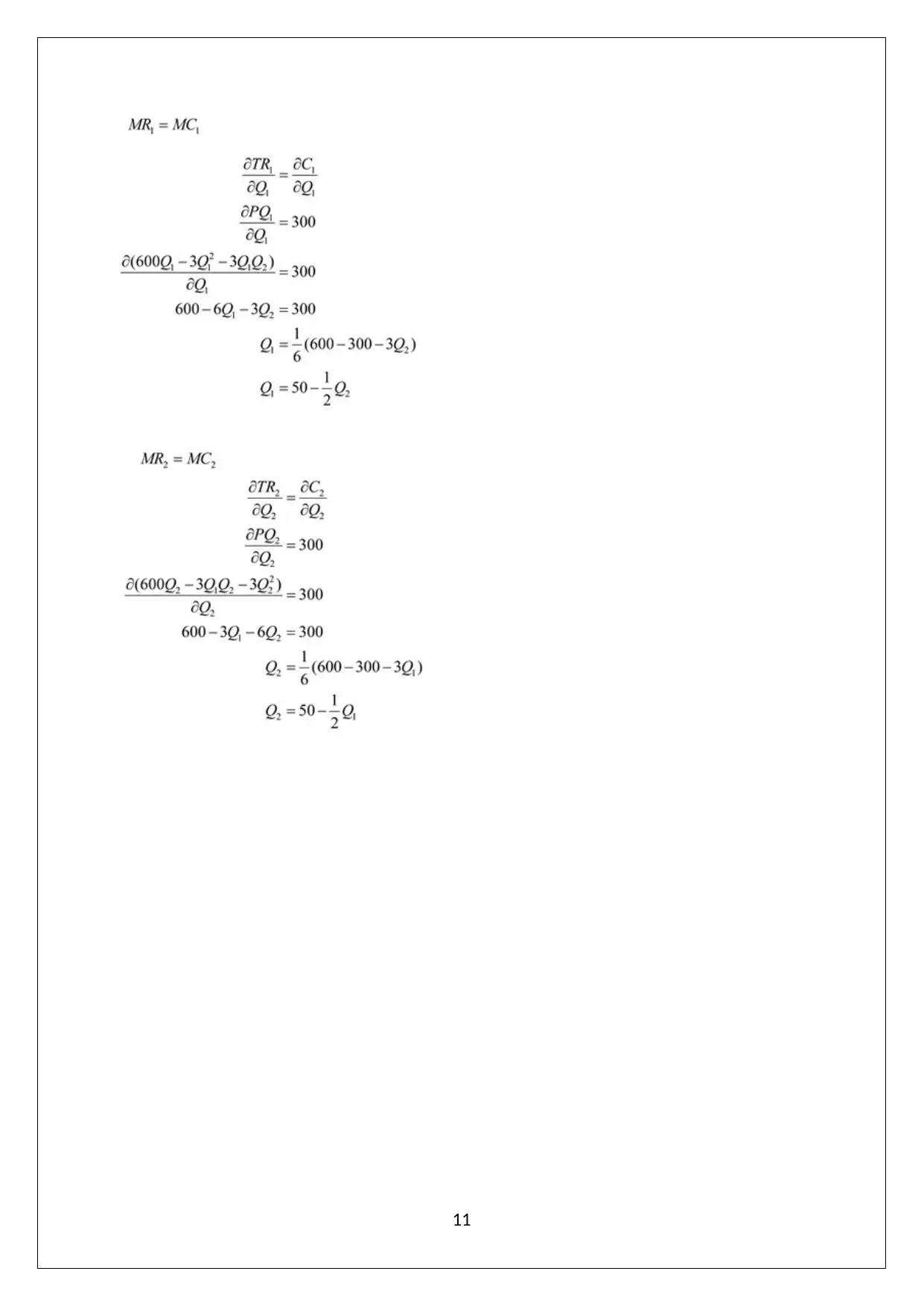
11
⊘ This is a preview!⊘
Do you want full access?
Subscribe today to unlock all pages.

Trusted by 1+ million students worldwide
1 out of 23
Related Documents
Your All-in-One AI-Powered Toolkit for Academic Success.
+13062052269
info@desklib.com
Available 24*7 on WhatsApp / Email
![[object Object]](/_next/static/media/star-bottom.7253800d.svg)
Unlock your academic potential
Copyright © 2020–2025 A2Z Services. All Rights Reserved. Developed and managed by ZUCOL.





